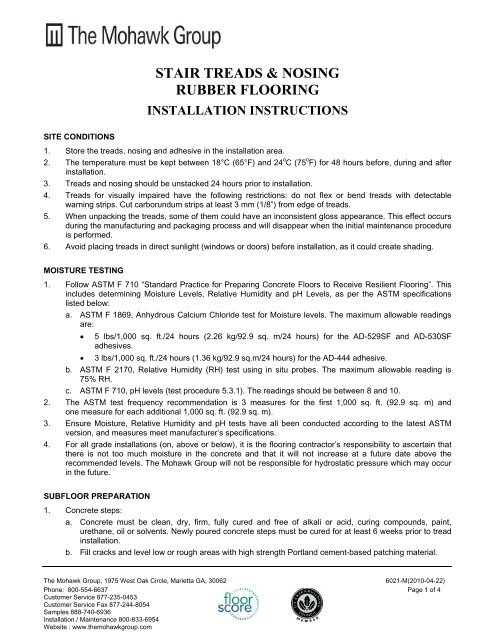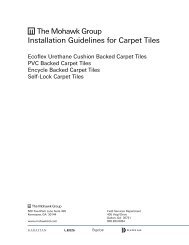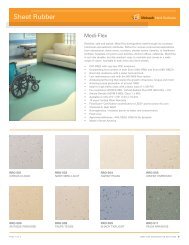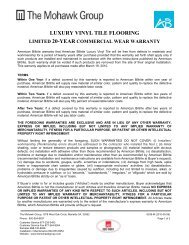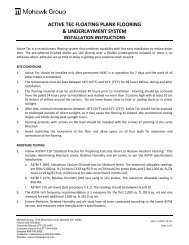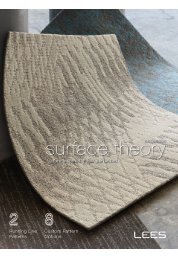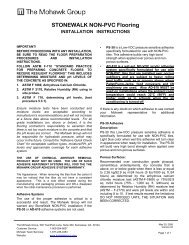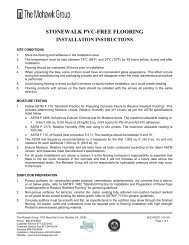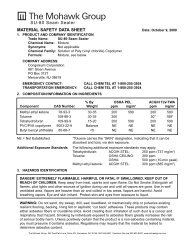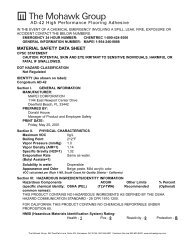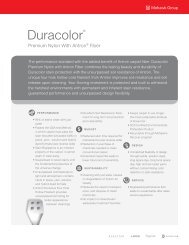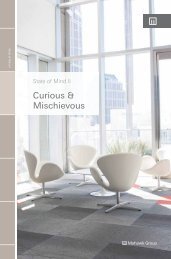STAIR TREADS & NOSING RUBBER FLOORING - Mohawk Group
STAIR TREADS & NOSING RUBBER FLOORING - Mohawk Group
STAIR TREADS & NOSING RUBBER FLOORING - Mohawk Group
Create successful ePaper yourself
Turn your PDF publications into a flip-book with our unique Google optimized e-Paper software.
<strong>STAIR</strong> <strong>TREADS</strong> & <strong>NOSING</strong><strong>RUBBER</strong> <strong>FLOORING</strong>INSTALLATION INSTRUCTIONSSITE CONDITIONS1. Store the treads, nosing and adhesive in the installation area.2. The temperature must be kept between 18°C (65°F) and 24 o C (75 o F) for 48 hours before, during and afterinstallation.3. Treads and nosing should be unstacked 24 hours prior to installation.4. Treads for visually impaired have the following restrictions: do not flex or bend treads with detectablewarning strips. Cut carborundum strips at least 3 mm (1/8”) from edge of treads.5. When unpacking the treads, some of them could have an inconsistent gloss appearance. This effect occursduring the manufacturing and packaging process and will disappear when the initial maintenance procedureis performed.6. Avoid placing treads in direct sunlight (windows or doors) before installation, as it could create shading.MOISTURE TESTING1. Follow ASTM F 710 “Standard Practice for Preparing Concrete Floors to Receive Resilient Flooring”. Thisincludes determining Moisture Levels, Relative Humidity and pH Levels, as per the ASTM specificationslisted below:a. ASTM F 1869, Anhydrous Calcium Chloride test for Moisture levels. The maximum allowable readingsare: 5 lbs/1,000 sq. ft./24 hours (2.26 kg/92.9 sq. m/24 hours) for the AD-529SF and AD-530SFadhesives. 3 lbs/1,000 sq. ft./24 hours (1.36 kg/92.9 sq.m/24 hours) for the AD-444 adhesive.b. ASTM F 2170, Relative Humidity (RH) test using in situ probes. The maximum allowable reading is75% RH.c. ASTM F 710, pH levels (test procedure 5.3.1). The readings should be between 8 and 10.2. The ASTM test frequency recommendation is 3 measures for the first 1,000 sq. ft. (92.9 sq. m) andone measure for each additional 1,000 sq. ft. (92.9 sq. m).3. Ensure Moisture, Relative Humidity and pH tests have all been conducted according to the latest ASTMversion, and measures meet manufacturer’s specifications.4. For all grade installations (on, above or below), it is the flooring contractor’s responsibility to ascertain thatthere is not too much moisture in the concrete and that it will not increase at a future date above therecommended levels. The <strong>Mohawk</strong> <strong>Group</strong> will not be responsible for hydrostatic pressure which may occurin the future.SUBFLOOR PREPARATION1. Concrete steps:a. Concrete must be clean, dry, firm, fully cured and free of alkali or acid, curing compounds, paint,urethane, oil or solvents. Newly poured concrete steps must be cured for at least 6 weeks prior to treadinstallation.b. Fill cracks and level low or rough areas with high strength Portland cement-based patching material.The <strong>Mohawk</strong> <strong>Group</strong>, 1975 West Oak Circle, Marietta GA, 300626021-M(2010-04-22)Phone: 800-554-6637 Page 1 of 4Customer Service 877-235-0453Customer Service Fax 877-244-8054Samples 888-740-6936Installation / Maintenance 800-833-6954Website : www.themohawkgroup.com
<strong>STAIR</strong> <strong>TREADS</strong> & <strong>NOSING</strong><strong>RUBBER</strong> <strong>FLOORING</strong>INSTALLATION INSTRUCTIONSc. AD-33 Solvent-Free Epoxy Stair Nosing Caulking Compound can be used for repairing worn or crackedsteps.2. Wooden steps:a. Wooden steps must be properly nailed, clean and free of polish and wax. Replace or repair old or wornsteps.b. Fill all surface cracks and holes with high strength Portland cement-based patching material.3. Terrazzo, ceramic, natural/agglomerated marble or granite-type steps are non-porous materials and requirespecial attention:a. These types of steps have a glazed and polished finish.b. Often they are treated with sealers and wax as well, which can build up. Remove glaze, polished finish,sealers and wax by sanding or bead blasting.c. Ensure that the surface is free of dirt, dust, debris or any other substances that may prevent bonding ofthe primer, then apply a coat of self-levelling Portland cement-based compound. Follow themanufacturer’s instructions and cure for at least 24 hours.d. Apply a 3 - 5 mm (1/8” to 3/16”) thick layer of the above compound over the cured primer and level it.e. Cure for 24 hours prior to installing Rubber products.4. Metal steps:a. The surface must be level, clean, dry and free of any coatings or foreign materials.b. Sand the metal (aluminium, steel, brass, copper and bronze) to ensure a good adhesive bond.5. We do not recommend using gypsum-based patching or levelling compounds under any circumstances.6. Do not use chemical adhesive removal products (chemical abatement products); their use will void the The<strong>Mohawk</strong> <strong>Group</strong> adhesive system warranty.7. For detailed instructions, refer to the Floor Preparation document available on our Web site atwww.themohawkgroup.com.ADHESIVE SYSTEMS1. The use of the proper adhesive is critical to a successful end result. The <strong>Mohawk</strong> <strong>Group</strong> will only guaranteeits flooring products if AD-444, AD-529SF or AD-530SF adhesive is used.2. On concrete and plywood steps, use AD-444, AD-529SFSF or AD-530SFSF with AD-33 Solvent-FreeEpoxy Stair Nosing Caulking Compound.3. On non-porous substrates and metal steps, use AD-530SFSF with AD-33 Solvent-Free Epoxy Stair NosingCaulking Compound.4. Protect from freezing in transit and storage.5. Trowel specifications are written as follows: width / depth / spacing.6. Use kneepads and work off the treads whenever possible.7. Clean spills, oozing and tools promptly using soapy water, ethyl alcohol or isopropyl alcohol.8. Do not reuse container. Dispose of container and adhesive in accordance with federal, provincial/state andlocal waste disposal regulations.The <strong>Mohawk</strong> <strong>Group</strong>, 1975 West Oak Circle, Marietta GA, 300626021-M(2010-04-22)Phone: 800-554-6637 Page 2 of 4Customer Service 877-235-0453Customer Service Fax 877-244-8054Samples 888-740-6936Installation / Maintenance 800-833-6954Website : www.themohawkgroup.com
<strong>STAIR</strong> <strong>TREADS</strong> & <strong>NOSING</strong><strong>RUBBER</strong> <strong>FLOORING</strong>INSTALLATION INSTRUCTIONS9. If there is any doubt about which adhesive to use, contact The <strong>Mohawk</strong> <strong>Group</strong> or its distributors foradditional information.AD-529SF or AD-530SF ADHESIVES1. AD-529SF is a two-part epoxy-based adhesive that is beige when mixed. AD-530SF is a two-partpolyurethane-based adhesive that is cream-colored when mixed.2. They create a very strong bond when applied to porous and non-porous surfaces.3. Remove the lid of part A and stir using a mechanical mixer. Remove the lid of part B and pour all thecontent into the container of part A. Use a rubber spatula to remove everything from the container. Use amechanical mixer to ensure proper blending, as inadequate mixing could cause bond failure.4. Pour the entire adhesive onto the floor immediately after mixing. Do not leave the mixed adhesive in theoriginal can; the heat generated by the chemical reaction will reduce the open time of the adhesive.5. Porous and non-porous surfaces: spread adhesive with a 1.6 mm x 1.6 mm x 1.6 mm (1/16'' x 1/16'' x1/16'') U-notched trowel on porous surfaces. Spread adhesive with a 1.6 mm x 0.8 mm x 0.8 mm (1/16'' x1/32'' x 1/32'') U-notched trowel on non-porous surfaces.6. Coverage: porous surfaces up to 15 sq. m /3.79 liters (up to 160 sq. ft./gal.); non-porous surfaces up to18.6 sq. m/3.79 liters (200 sq. ft./gal.).7. Curing time will vary depending on site conditions (i.e. temperature, humidity). It is still workable if it is wetand sticks to the fingers when touched. If a dry skin has formed on the surface of the adhesive, remove theadhesive and start over.8. The treads must be rolled prior to adhesive hardening with a J-type hand roller.9. We recommend the following guidelines for traffic: First 24 hours: no traffic; 24 to 72 hours: light traffic only.AD-444 ADHESIVE1. AD-444 is a wet-set adhesive; it is off-white with a syrupy consistency.2. Porous surfaces: spread adhesive with a 1.6 mm x 1.6 mm x 1.6 mm (1/16'' x 1/16'' x 1/16'')square-notched trowel. Allow 15-25 minutes open time. Working time on concrete is up to 90 minutes,depending on temperature and humidity.3. Non-porous surfaces: spread adhesive with a 1.6 mm x 0.8 mm x 2.0 mm (1/16'' x 1/32'' x 5/64'')U-notched trowel. Allow 30-40 minutes open time. Working time on concrete is up to 2 hours, depending ontemperature and humidity.4. Coverage: porous surfaces up to 11.6 sq. m/3.79 liters (up to 125 sq. ft./gal.); non-porous surfaces up to14.9 sq. m/3.79 liters (160 sq. ft./gal.).5. The treads must be rolled prior to adhesive hardening with a J-type hand roller.6. We recommend the following guidelines for traffic:Up to 24 hours following installation: no traffic;The <strong>Mohawk</strong> <strong>Group</strong>, 1975 West Oak Circle, Marietta GA, 300626021-M(2010-04-22)Phone: 800-554-6637 Page 3 of 4Customer Service 877-235-0453Customer Service Fax 877-244-8054Samples 888-740-6936Installation / Maintenance 800-833-6954Website : www.themohawkgroup.com
<strong>STAIR</strong> <strong>TREADS</strong> & <strong>NOSING</strong><strong>RUBBER</strong> <strong>FLOORING</strong>INSTALLATION INSTRUCTIONSBetween 24 and 72 hours: light traffic;After 72 hours: moderate to heavy traffic.AD-33 ADHESIVE1. AD-33 is a two-part solvent-free epoxy caulking compound. It prevents cracking and flexing of rubber treadsand nosings by bonding uniformly to the under-step.2. It is excellent for the complete restoration of existing concrete, wooden or metal steps, and can be used forrepairing cracks, holes, depressions and worn or broken edges.3. Directions:a. Cut a 9 mm (3/8”) inside diameter opening in the mixing nozzle.b. Remove cap and attach the mixing nozzle to the cartridge using the retaining nut.c. Depress the trigger on the gun until the compound reaches the end of the nozzle.d. Discard the first 2.5 - 5.0 cm (1-2”) of compound. Do not remove internal mixer in nozzle.e. Squeeze a sufficient amount inside the nosing of the tread nosing so that when it is pressed firmly inplace, the compound moulds it to the shape of the step edge.f. After installing the tread nosing, thoroughly roll it with a J-type hand roller, especially in the nosing area.All of the tread nosing must touch the step edge to provide adequate support.g. Coverage: approx. 15 linear m (50 linear ft.) per unit using a 6 mm (¼”) diameter bead.h. To save a partial cartridge or compound for future use, leave the mixing nozzle on the cartridge duringstorage. To use, simply replace the old nozzle with a new one.WARNING: REMOVAL OF OLD <strong>FLOORING</strong>Do not sand, dry sweep, dry scrape, drill, saw, bead blast, mechanically chip or pulverize existing resilientflooring, backing, lining felt, paint, asphaltic cutback adhesives or other adhesives. These products may containasbestos fibers or crystalline silica. Avoid creating dust as inhalation increases the risk of cancer and respiratorydiseases. Smokers exposed to asbestos fibers are at greater risk of serious bodily harm. Unless certain that theproduct is asbestos-free, assume that it contains asbestos. Regulations may require that material be tested todetermine asbestos content. Consult the Resilient Floor Covering Institute’s (RFCI’s) recommendations forremoval of existing resilient floor coverings.The <strong>Mohawk</strong> <strong>Group</strong>, 1975 West Oak Circle, Marietta GA, 300626021-M(2010-04-22)Phone: 800-554-6637 Page 4 of 4Customer Service 877-235-0453Customer Service Fax 877-244-8054Samples 888-740-6936Installation / Maintenance 800-833-6954Website : www.themohawkgroup.com


